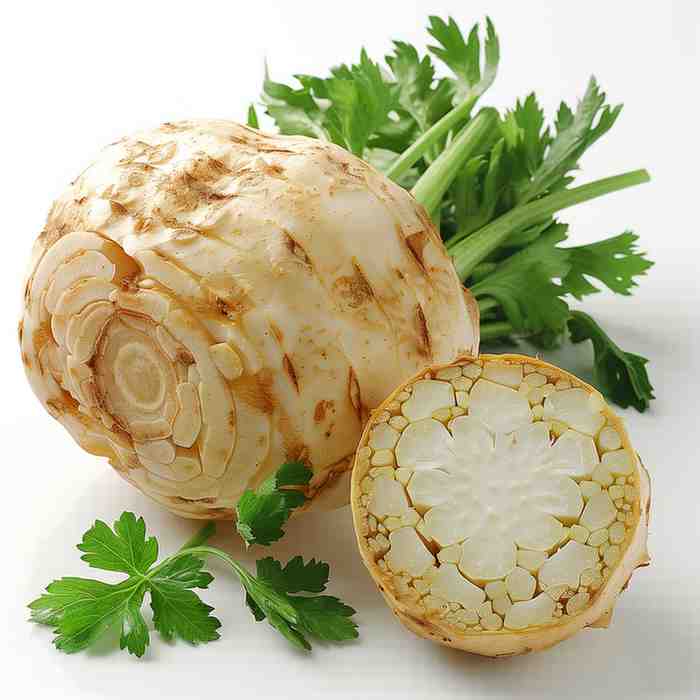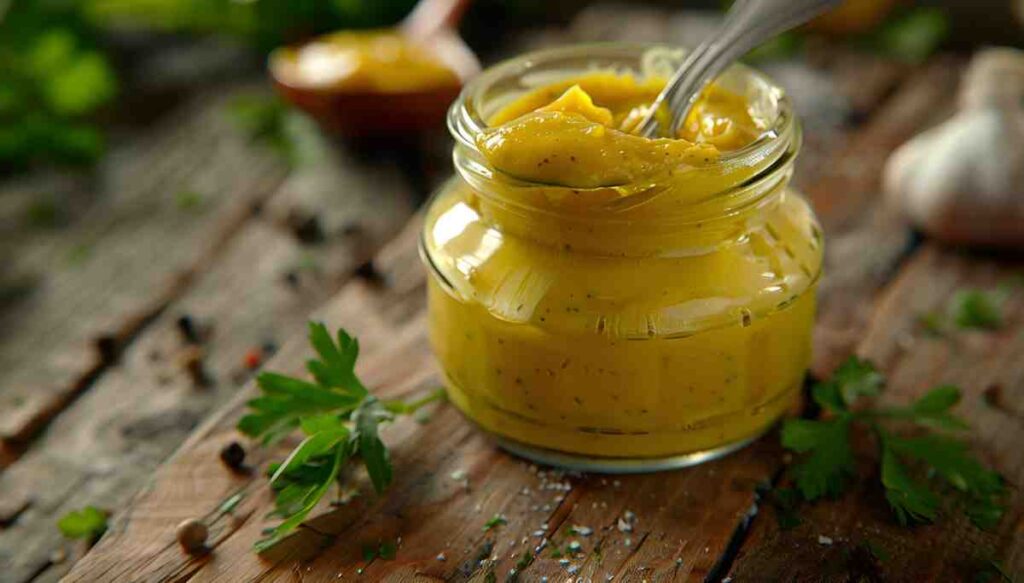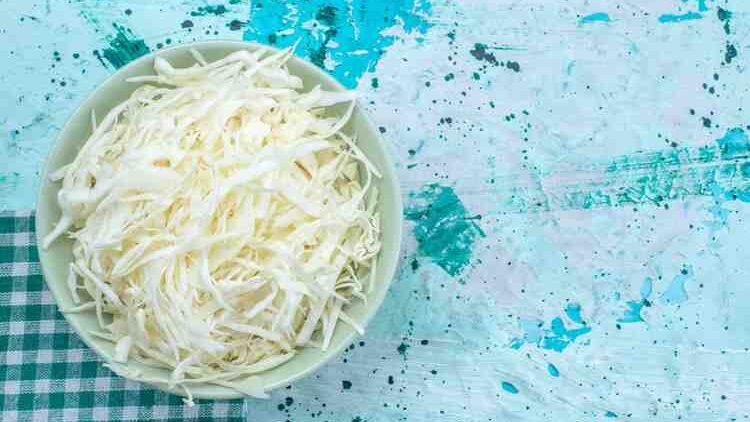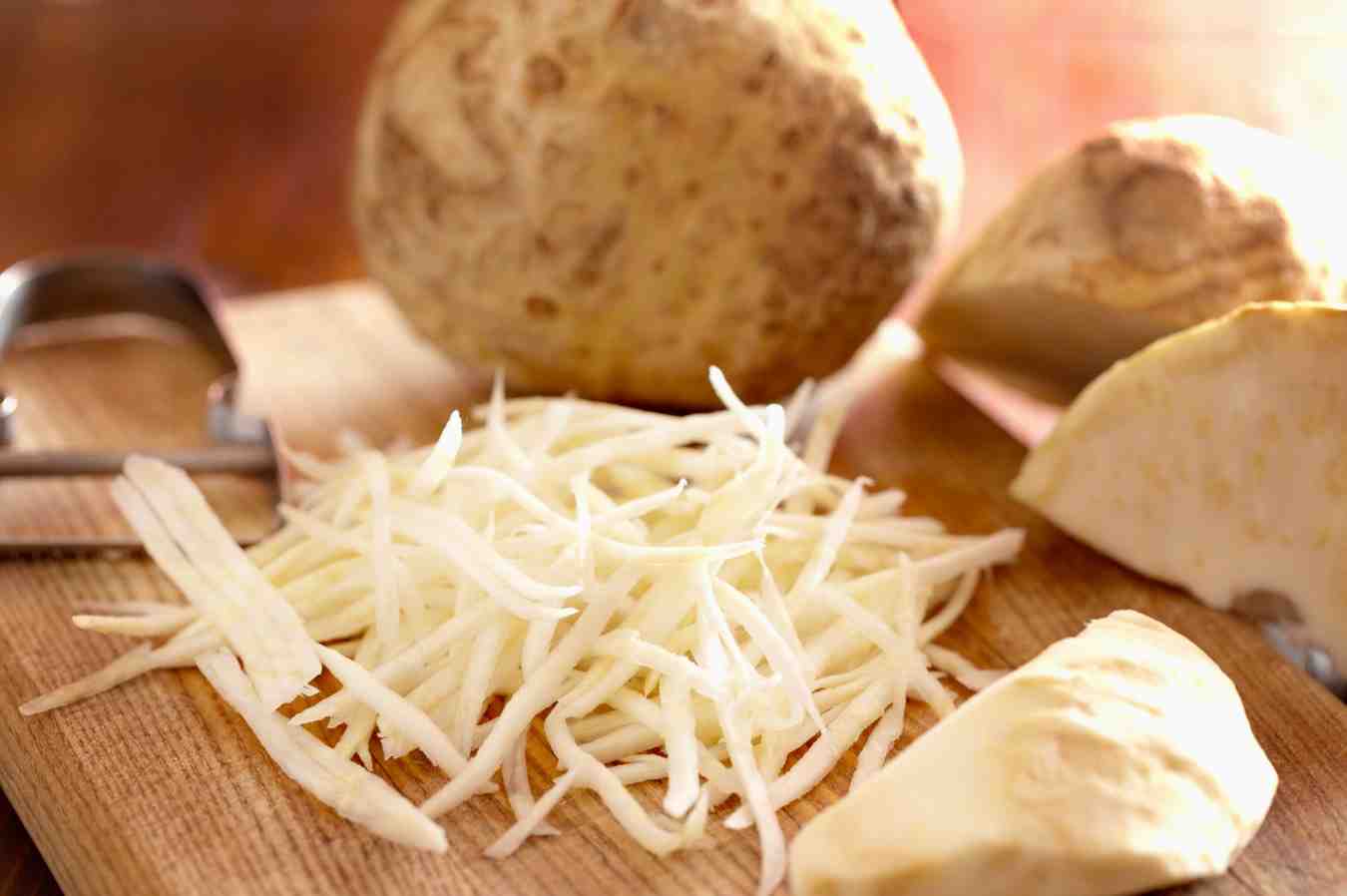Celeriac remoulade with toasted walnuts combines the creamy tanginess of a French-style remoulade with the earthy crunch of toasted walnuts. This delightful dish, centered around the versatile celeriac (celery root), offers a refreshing yet flavorful balance, making it a great addition to any meal. Whether served as a side or a light appetizer, it brings a refined touch of French cuisine to your table. Let’s explore the ingredients, preparation, and tips to perfect this recipe.
What is Celeriac Remoulade?
Celeriac remoulade is a French classic, known for its creamy, tangy dressing and finely shredded celeriac. The remoulade is traditionally made with mustard, mayonnaise, vinegar, and a touch of seasoning, creating a fresh, zesty contrast to the slightly nutty, earthy flavor of the celeriac. By adding toasted walnuts, this dish takes on new texture and flavor, providing an extra crunch that complements the creamy base.
Ingredients of a Traditional Celeriac Remoulade

The basic components of a celeriac remoulade include:
- Celeriac (celery root): The star ingredient, shredded finely for a slaw-like texture.
- Mustard: Dijon mustard is the classic choice, providing sharpness and depth.
- Mayonnaise: Adds creaminess and richness to the dressing.
- Vinegar: Usually white wine vinegar, balancing the richness with acidity.
- Seasoning: Salt, pepper, and fresh herbs (such as parsley or tarragon) to enhance the flavor.
The Role of Toasted Walnuts
Toasted walnuts elevate this dish, adding an earthy, nutty flavor and crunch. The toasting process intensifies the walnut’s natural oils, deepening its flavor. The contrast between the creamy dressing and the crunchy walnuts provides a delightful textural variety. Plus, walnuts offer nutritional benefits, including healthy fats and antioxidants, making this dish as wholesome as it is tasty.
How to Prepare Celeriac Remoulade with Toasted Walnuts
Ingredients You’ll Need
To prepare this dish, gather the following ingredients:
- One medium celeriac
- 2 tablespoons of Dijon mustard
- 4 tablespoons of mayonnaise
- 2 tablespoons of white wine vinegar
- ½ cup of walnuts, toasted
- Fresh herbs (such as parsley or tarragon)
- Salt and pepper to taste
Step-by-Step Instructions
- Prepare the celeriac: Begin by peeling the tough outer skin of the celeriac. Once peeled, you can either grate or matchstick the celeriac, depending on your preference for texture. Both methods yield delicious results.
- Make the remoulade dressing: In a large bowl, mix together the mustard, mayonnaise, and vinegar until well combined. Season with salt and pepper, and add freshly chopped herbs to taste.
- Toast the walnuts: Heat a dry skillet over medium heat and add the walnuts. Stir frequently until the nuts are golden and fragrant, which usually takes around 5 minutes. Allow them to cool before roughly chopping.
- Combine the ingredients: Add the shredded or matchsticked celeriac to the bowl with the dressing and mix well. Gently fold in the toasted walnuts, ensuring that the flavors are evenly distributed.
- Chill and serve: For the best flavor, allow the remoulade to chill in the refrigerator for at least 30 minutes before serving. This gives the flavors time to meld.

Grating vs. Matchsticking Celeriac: Which is Best?
Can You Grate Celeriac?
Yes, grating celeriac is one of the most popular ways to prepare it for remoulade. Grated celeriac has a finer, slaw-like texture that allows the creamy dressing to coat each strand thoroughly. It’s quick and easy, especially if you use a food processor.
How to Matchstick Celeriac
For a more rustic texture, you can cut the celeriac into matchsticks. This method, also known as julienning, creates longer, slightly thicker pieces that retain more of the celeriac’s natural crunch. To achieve uniform matchsticks, use a sharp knife or a mandoline slicer.
Which Method Should You Choose?
It ultimately depends on your preference:
- Grated celeriac results in a smoother, more integrated dish.
- Matchsticked celeriac provides more crunch and a visually striking presentation.
Health Benefits of Celeriac and Walnuts
Celeriac and walnuts are not only flavorful but also packed with nutrients. Here’s a look at their health benefits:
Nutritional Value of Celeriac
Celeriac is low in calories but high in nutrients, making it an excellent choice for a light yet satisfying dish. It’s rich in fiber, vitamins C and K, and antioxidants, which support immune function, bone health, and skin health. The fiber in celeriac also aids digestion, making this dish as healthy as it is delicious.
Why Walnuts Are Good for You
Walnuts are a superfood, loaded with healthy fats, omega-3 fatty acids, and antioxidants. They support heart health, reduce inflammation, and can even improve brain function. Adding toasted walnuts to celeriac remoulade not only boosts the flavor but also enhances the dish’s nutritional profile.
How to Serve Celeriac Remoulade with Toasted Walnuts
Celeriac remoulade with toasted walnuts is a versatile dish that can be served in numerous ways, making it a great addition to many meals. Whether you’re planning a casual lunch or an elegant dinner, this dish pairs well with a variety of proteins or can stand on its own as a flavorful appetizer. Let’s explore some pairing ideas and how you can elevate the presentation for different occasions.
Perfect Pairings: What Goes Well with Celeriac Remoulade
Pairing with Proteins
Celeriac remoulade complements several proteins by adding a light, refreshing contrast to richer dishes. Here are a few ideal pairing options:
- Grilled Fish: The tangy remoulade works beautifully with the subtle flavors of grilled or poached fish like salmon, trout, or cod.
- Roast Chicken: The creamy, slightly sharp taste of the remoulade provides balance to the savory, rich flavors of roast chicken.
- Charcuterie: For a more French-inspired meal, serve the remoulade alongside cured meats such as prosciutto, ham, or pâté. The creamy dressing contrasts perfectly with the saltiness of the meats.

Vegetarian Pairings
For a vegetarian-friendly spread, celeriac remoulade pairs wonderfully with roasted vegetables or as a component in a salad platter:
- Roasted Vegetables: Combine with roasted root vegetables like carrots, beets, or sweet potatoes to enhance the earthy flavors.
- Grilled Cheese: Pair with grilled halloumi or other firm cheeses to create a rich, savory vegetarian option.
Serving Ideas for Different Occasions
Elegant Dinner Party Presentation
For a formal dinner setting, present the celeriac remoulade in small portions on individual plates. Top each serving with extra toasted walnuts and a sprinkle of fresh herbs for added color and flavor. For an upscale touch, use a ring mold to shape the remoulade neatly on the plate.
Casual Gatherings or Buffets
For more casual events or buffets, consider offering celeriac remoulade as part of a larger spread. It works well as a topping for crostini, creating delicious bite-sized appetizers. Serve it alongside a variety of breads, crackers, and dips to encourage guests to build their own snacks
Creative Recipe Variations and Twists
Adding Roasted Pears for a Sweet Contrast
One popular variation of celeriac remoulade includes roasted pears, adding a subtle sweetness that balances the tanginess of the dressing. To do this, simply roast slices of pear in the oven with a drizzle of olive oil until golden and soft. Once roasted, chop the pears and gently fold them into the remoulade for an added layer of flavor.
Experimenting with Different Nuts
Although walnuts are commonly used in this recipe, other nuts can offer their own unique flavors and textures:
- Pecans: Add a richer, sweeter crunch to the dish.
- Almonds: Provide a lighter, more delicate texture.
- Hazelnuts: Introduce a bold, roasted flavor that complements the earthy celeriac.
Vegan and Dairy-Free Options
For those following a vegan or dairy-free diet, simple substitutions can make celeriac remoulade suitable for all. Use plant-based mayonnaise instead of traditional mayo, and ensure the Dijon mustard you select is dairy-free. The toasted walnuts remain a great addition, enhancing the dish with flavor and crunch without any animal-based ingredients.
Storage and Make-Ahead Tips for Celeriac Remoulade
How to Store Celeriac Remoulade
Celeriac remoulade can be stored in the refrigerator for up to three days in an airtight container. In fact, letting the dish sit for a day or two allows the flavors to meld, making it even tastier when served later. Just be sure to give it a good stir before serving, as the dressing may separate slightly during storage.
Make-Ahead Recommendations
Celeriac remoulade is an excellent dish to prepare ahead of time, especially for busy schedules or events. You can make the remoulade a day in advance and store it in the refrigerator. If you want to keep the walnuts extra crunchy, add them just before serving to prevent them from softening in the dressing.
Top Tips for Making the Perfect Celeriac Remoulade
Making a perfect celeriac remoulade requires a few important steps. By following these tips, you’ll be able to create a dish that has the ideal texture, flavor, and presentation.
First, choose fresh celeriac. It’s important to start with firm, fresh celeriac that doesn’t have soft spots or blemishes. Fresh celeriac will give your dish a better flavor and texture, making a noticeable difference in the final result.
Next, peel the celeriac thoroughly. Celeriac has thick, tough skin, so be sure to remove it completely. If you don’t peel it well, the outer layer can be fibrous, affecting the smooth texture of your remoulade.
When it comes to cutting the celeriac, grate or slice it evenly. Uniformly grated or sliced celeriac helps ensure the remoulade has a consistent texture throughout. A mandoline slicer can make this task easier and more precise.
After preparing the remoulade, remember to chill it before serving. Letting it rest in the fridge for at least 30 minutes allows the flavors to blend together nicely. This step is key for a well-balanced, refreshing dish.
While toasting the walnuts, be careful not to burn them. Toast the walnuts until they’re just golden brown. This brings out their flavor without making them bitter, adding a nice crunch to your remoulade.
Also, make sure your dressing is balanced. A good remoulade dressing combines mustard, vinegar, and mayonnaise in the right proportions. This creates a creamy texture with a tangy flavor that complements the celeriac.
Finally, add fresh herbs just before serving. Herbs like parsley or tarragon can brighten up the flavor of the remoulade. However, if you add them too early, they can wilt and lose their vibrant taste.
FAQs: Answering Common Questions About Celeriac Remoulade
What is celeriac remoulade made of?
Celeriac remoulade is a French dish made from finely shredded or matchsticked celeriac (celery root) mixed with a tangy dressing. The dressing typically consists of Dijon mustard, mayonnaise, vinegar, and seasoning. Variations often include the addition of toasted walnuts, fresh herbs, or even capers.
How many calories are in celeriac remoulade?
The calorie count of celeriac remoulade can vary based on the amount of mayonnaise or oil used in the dressing. On average, a serving contains approximately 150 to 200 calories. Adding walnuts may increase the calorie count slightly but also boosts the dish’s nutritional value with healthy fats and antioxidants.
Can you grate celeriac?
Yes, grating celeriac is a popular way to prepare it for remoulade. Grating creates a fine, slaw-like texture that allows the dressing to coat each strand thoroughly. Using a box grater or food processor makes the task quicker and easier.
How to matchstick celeriac?
Matchsticking (or julienning) celeriac involves peeling the root and slicing it into thin, uniform strips. This method, often done with a sharp knife or mandoline slicer, results in longer pieces that offer more crunch compared to grated celeriac.

